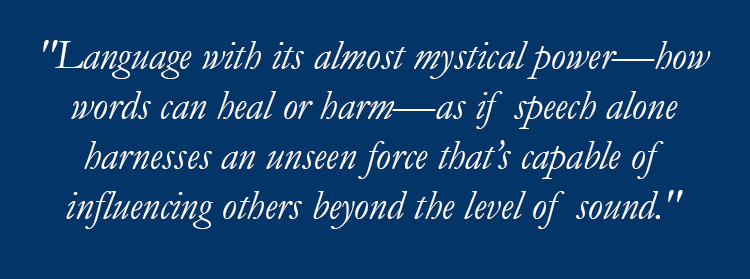 Language with its almost mystical power—how words can heal or harm—as if speech alone harnesses an unseen force that’s capable of influencing others beyond the level of sound. It’s more than vibratory waves transduced by the cochlea of the inner ear, more than a physiological response.
Language with its almost mystical power—how words can heal or harm—as if speech alone harnesses an unseen force that’s capable of influencing others beyond the level of sound. It’s more than vibratory waves transduced by the cochlea of the inner ear, more than a physiological response.
All of us are aware of this power, but we can’t explain it. We simply know it exists. We are in part shaped by experience, but language provides the powder and spark of making sense of things. Memory stores not only a vision of the past, but the fabric and texture of recollected words and phrases, idioms and locutions, that are then used to decipher the world.
In many instances, our earliest influences tend to be the strongest. We forget at once most incidental physical harm we encounter as children, but the wrong word from a parent spoken in the wrong tone at the wrong time can stay with us forever. Along these lines, there’s a large and growing body of medical literature that describes the adverse effects to children who are victims of long-term emotional abuse.
Long-term childhood abuse can cause permanent physiological changes to the brain including decreased volume of the hippocampus1 as well as decreased volume of the corpus callosum, the cerebellum, and the prefrontal cortex.2 As well, there’s even medical literature that suggests a relationship between verbal abuse and the development of asthma.3
Just as words can damage the structures of the brain so too can they damage the ways in which we come to perceive and apprehend the world. But words can heal as well as harm. Psychiatrists, psychologists, ministers, and others who heal have known this for years. We’ve all witnessed instances where words alone have changed lives. A word of praise or encouragement, a spur-of-the-moment insight, a simple truth spoken at precisely the right time—these can show the way forward, shape outcomes, make all the difference.
“Because even the smallest of words,” writes Natsuki Takaya, “can be the ones to hurt you, or save you.” What this means is that anyone who has access to the public mind should be mindful of what they say and how they say it. Lawyers in particular should be mindful of both the substance and tone of their speech. In a contested proceeding many fail to resist the tendency to raise the temperature level, mistakenly believing that the greater heat equates to a brighter light. But often the opposite is true—it’s the words, and words alone, that possess the ultimate power.
1See Teichera, et al., Childhood maltreatment is associated with reduced volume in the hippocampal subfields CA3, dentate gyrus, and subiculum, Proceedings of the National Academy of Sciences of the United States of America, (Vol. 109 No. 9)(September 19, 2011)(“Childhood maltreatment or abuse is a major risk factor for mood, anxiety, substance abuse, psychotic, and personality disorders, and it is associated with reduced adult hippocampal volume, particularly on the left side.”)(http://www.pnas.org/content/109/9/E563.full)
2See Child Welfare Information Gateway, Understanding the Effects of Maltreatment on Brain Development, Issue Briefs, (2015)(“Maltreated children and adolescents tend to have decreased volume in the corpus callosum, which is the largest white matter structure in the brain and is responsible for interhemispheric communication and other processes (e.g.,arousal, emotion, higher cognitive abilities) (McCrory, De Brito, & Viding, 2010; Wilson, Hansen, & Li, 2011).”). https://www.childwelfare.gov/ pubPDFs/brain_development.pdf#page= 5&view= Effects of maltreatment on brain development
3See Remigio-Baker, et al., Adverse Childhood Events are Related to the Prevalence of Asthma and Chronic Obstructive Pulmonary Disorder Among Adult Women in Hawaii, Lung (Dec. 2015)(193(6):885-91)(“Verbal abuse was also associated with greater likelihood for asthma…”)




